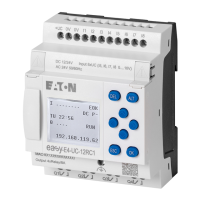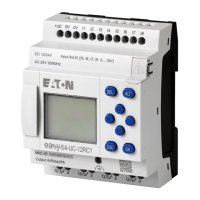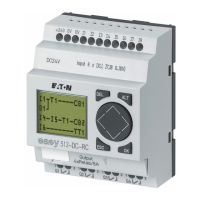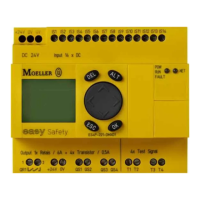6. Function blocks
6.2 Interrupt function blocks
Operands Bit inputs
LE - Output backlight
x
P device buttons
x
I - Bit input
x
Q - Bit output
x
Q - Bit output of a FB
x
2)
Only on projects with ≥ 2 base devices on NET
Operating modes
Description Note
On-delayed
If the time set at function block input PD is
reached, the system will jump to the interrupt
program once
Interval
If the time set at function block input PD is
reached, the system will jump to the interrupt
program. The time measurement will start again
and, after it elapses, the system will jump to the
interrupt program again. This will keep hap-
pening as long as function block input EN = 1.
IT interrupt function blocks feature two operating modes that work as described
below:
l
On-delayed
The interrupt function block is enabled via function block input EN. The pulse/-
pause time at function block input PD starts to count down. When the pulse/-
pause time at function block input PD elapses, the interrupt is triggered
immediately and the interrupt program is processed.
l
Interval
The interrupt function block is enabled via function block input EN. The pulse time
at function block input PD starts to count down. When the pulse time at function
block input PD elapses, the interrupt is triggered immediately and the interrupt
program is processed. After this, the pause time at function block input PD starts
to count down. When the pause time at function block input PD elapses, the inter-
rupt is triggered immediately and the interrupt program is processed. This means
that the interrupt is triggered twice: once at the end of the pulse and once at the
end of the pause.
Function block outputs
Description Note
(bit)
Q1
Bit output used to provide operand states from
the interrupt program to the main program.
Q2
Q3
Q4
(DWord)
QV
Elapsed actual time of delay set at PD
easyE402/24 MN050009ENEaton.com
583

